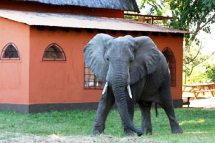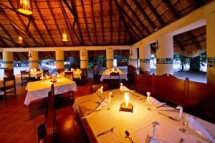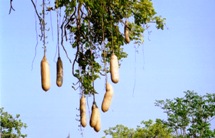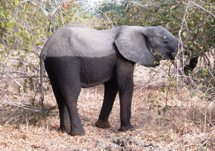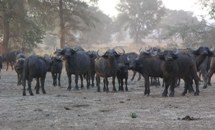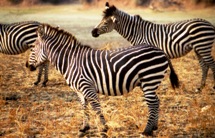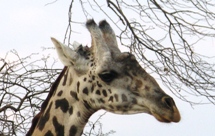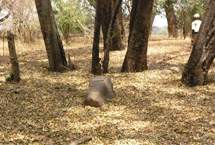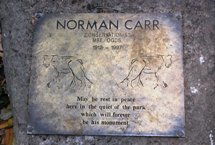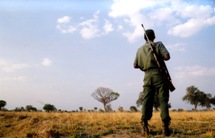Zambia (1): Day TwentyOne : Puku Ridge Camp to Flatdogs Camp
We left Puku Ridge at 7.00 a.m., heading for our final destination in South Luangwa, Flatdogs Camp (‘Flatdogs’ is the quite descriptive local name for crocodiles!).
Historically Flatdogs hadn’t really fitted into our portfolio, since it was aimed more towards the overland truck or backpacking market. However, although these were still catered for, the camp had recently expanded to include conventional safari accommodation, albeit still at extremely reasonable prices. We therefore wanted to see if it would be suitable for inclusion in what we wanted to offer to guests.
Well, we certainly weren’t disappointed! The welcome we were given was especially warm, the accommodation provided was great, with both chalets (![]() ) and en-suite safari tents available, and there is even a great swimming pool on site. And, in contrast to most safari lodges, where the main meals are communal affairs at set times, here you could dine whenever you liked, receiving delicious and freshly cooked food in their spacious restaurant area (
) and en-suite safari tents available, and there is even a great swimming pool on site. And, in contrast to most safari lodges, where the main meals are communal affairs at set times, here you could dine whenever you liked, receiving delicious and freshly cooked food in their spacious restaurant area (![]() ).
).
We quickly realised that there was an unexplored area of the market here, which most tour operators were unaware of, in which you could experience 80% of what the top-end lodges provided, at just 30% of the cost (after all, the game doesn’t know where you slept last night). As a result, and after further exploration, AfricaAway has become noted for providing the widest possible cost range of safaris.
Located near to the main gate of the South Luangwa Park, Flatdogs was able to provide us with a much-needed opportunity to get some final photographs. I learned a long time ago that you can either view the wildlife, and its interaction with other creatures and its environment, or you can concentrate on getting good photographs of the same, but rarely both, and I had therefore tended to prefer the actual experience over the photographic record.
On this final day, therefore we set out to fill the gaps in our collection. First off was the ubiquitous ‘Sausage Tree’ or ‘Kigelia’ (![]() ). This bizarre tree produces fruit that can grow up to several feet in length, and which are so dense you can barely lift them. For some reason driver guides like to choose Sausage Trees to park under at drinks time, which can be somewhat hazardous if the tree chooses to drop its fruit (which ultimately provides sustenance to a wide variety of wildlife).
). This bizarre tree produces fruit that can grow up to several feet in length, and which are so dense you can barely lift them. For some reason driver guides like to choose Sausage Trees to park under at drinks time, which can be somewhat hazardous if the tree chooses to drop its fruit (which ultimately provides sustenance to a wide variety of wildlife).
We were also fortunate to get an excellent shot of a crocodile sunning itself on the river bank (![]() ), together with an interesting photo of an elephant, complete with tidemark, which had just crossed the river at a fairly deep point (
), together with an interesting photo of an elephant, complete with tidemark, which had just crossed the river at a fairly deep point (![]() ).
).
Further buffalo (![]() ) shots were too good to miss. Finally we realised that zebra (
) shots were too good to miss. Finally we realised that zebra (![]() ) are so ubiquitous that often one neglects to photograph these very elegant animals, the same being true of giraffe (
) are so ubiquitous that often one neglects to photograph these very elegant animals, the same being true of giraffe (![]() ).
).
During our afternoon drive we also made a detour to visit the final resting place of Norman Carr. Back in the days when an African safari was a hunting experience, Norman developed the pioneering idea of taking people to look at animals and photograph them rather than to shoot them, establishing Luangwa's first safari camp in 1950.
Of almost equal importance, he was also responsible for developing the idea of the walking safari, which has become Zambia's, and indeed AfricaAway’s, specialist activity.
Norman’s grave site is located in a beautiful grove of trees on the banks of the Luangwa river. It is quite easy to visit, since it is just a few yards away from one of South Luangwa’s road routes, but it’s a fairly obscure route, and therefore it is unlikely that you will encounter any other visitors while visiting here.
Which is good, because it is an extraordinarily peaceful spot, and quite an emotional experience to visit here: we try to make such a ‘pilgrimage’ each time we visit South Luangwa. I’m not one to spend much time contemplating what happens to you after you die, but I must say that I can’t imagine a finer last resting place (![]() ). The grave's memorial plaque is simple but moving (
). The grave's memorial plaque is simple but moving (![]() ).
).
![]()
On one occasion we asked our guide what had been his scariest moment, and he told of one that had taken place on safari elsewhere. In the South Luangwa, the scout might typically carry a .458 Winchester capable of stopping anything (![]() ). Customarily it will carry 3 or 4 shells in its internal magazine. The first will be soft nosed, for the dual purpose of a warning shot for game such as elephant or buffalo, or as a dropping shot for soft-skinned animals such as lion. The remainder are then hard nosed shells capable of dropping an elephant.
). Customarily it will carry 3 or 4 shells in its internal magazine. The first will be soft nosed, for the dual purpose of a warning shot for game such as elephant or buffalo, or as a dropping shot for soft-skinned animals such as lion. The remainder are then hard nosed shells capable of dropping an elephant.
On the occasion referred to, the scout was armed only with an AK47, ideal for carving up human beings, but of little use against big game. The on-foot group (comprising scout, guide and one guest) were very much being faced with a buffalo ‘moment’, as the latter was charging straight at them.
The guide admitted to being slightly nervous to start with, but at moments like these it is the scout who is in charge. Then as the enraged buffalo got nearer and nearer (at top speed they can reach 40 mph), the guide became even more nervous.
Finally the scout said – to the guest – “please tell me when you have your photograph, sir, so that I can shoot”. The guest dropped his camera and curled into a ball, as the scout then fired off a salvo of shots into the ground directly in front of the buffalo, kicking up lots of dirt into its face, whereupon it wheeled away. Phew!
| Back to previous page (Day 20) | Forward to next page (Day 22) |
